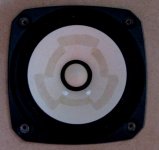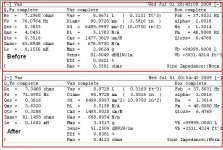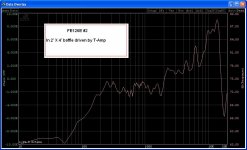You are doing just fine. After some time you will notice that one half of the pen tip protrudes slightly farther than the other. How you manipulate the beginning of the pressure on the brass portion will help to determine how much wider than the actual pen tip the stripe will be. You will find that a tip that is about 2/3's the width of the outside blocks, on your pattern guide, will be just about right.
As for stealth, you may find a hobby shop with polly S paints nearby. If not, the Testors flat colored, acrylic paint will also work, but it does not flow as well as the Poly S.
Just keep practicing with that upside down pen tip orientation and in a bit you will begin to understand the process. Wavering lines are not an issue here, nor is a small amount of block pattern overlap from ring to ring. Blobs and snaky lines is how we all started out.
Bud
As for stealth, you may find a hobby shop with polly S paints nearby. If not, the Testors flat colored, acrylic paint will also work, but it does not flow as well as the Poly S.
Just keep practicing with that upside down pen tip orientation and in a bit you will begin to understand the process. Wavering lines are not an issue here, nor is a small amount of block pattern overlap from ring to ring. Blobs and snaky lines is how we all started out.
Bud
Damask pretreatment
I've just put the damask pattern on one of mt FE126E and let it dry. Swept response measurements of the driver before and after (on a large open baffle board) don't seem to indicate any difference. It's a pretty simple pattern and I applied it with a small brush (see picture). Does it take multiple coats?
Thanks
Denis
I've just put the damask pattern on one of mt FE126E and let it dry. Swept response measurements of the driver before and after (on a large open baffle board) don't seem to indicate any difference. It's a pretty simple pattern and I applied it with a small brush (see picture). Does it take multiple coats?
Thanks
Denis
Attachments
On closer inspection I can see a db or so knocked off some the of the peaks. I'm also seeing some small changes in TSP (e.g. FS is down ~ 1 hz).
dhenryp
To match what Dave provides you will want to widen the radial component of that patterns, to the same width as the circumferential portion.. However, if you have two baffles and can place the drivers in a way that allows for a stereo illusion, it would be interesting to hear your comments on the change in sound quality, with thinner and then thicker radial legs.
If not, you can mount them nude on stands, with the magnet braced to get the frame vertical to the floor, along with setting them on some closed cell packing foam to kill most of the reflections from the stand platform. They will still provide bass down to 80 Hz done in this fashion and will not suffer the indignities forced on them by any sort of baffle. You might even grow to like the omni sound, once the EnABL patten has been fully applied.
For the most part, the objective tests do not provide enough information to make treatment decisions with.
Bud
To match what Dave provides you will want to widen the radial component of that patterns, to the same width as the circumferential portion.. However, if you have two baffles and can place the drivers in a way that allows for a stereo illusion, it would be interesting to hear your comments on the change in sound quality, with thinner and then thicker radial legs.
If not, you can mount them nude on stands, with the magnet braced to get the frame vertical to the floor, along with setting them on some closed cell packing foam to kill most of the reflections from the stand platform. They will still provide bass down to 80 Hz done in this fashion and will not suffer the indignities forced on them by any sort of baffle. You might even grow to like the omni sound, once the EnABL patten has been fully applied.
For the most part, the objective tests do not provide enough information to make treatment decisions with.
Bud
Re: Damask pretreatment
Looks like you have enuff... The damar works in conjunction with the puzzlekoat. The whole is greater than the sum of the parts.
dave
dhenryp said:I've just put the damask pattern on one of mt FE126E and let it dry. Swept response measurements of the driver before and after (on a large open baffle board) don't seem to indicate any difference. It's a pretty simple pattern and I applied it with a small brush (see picture). Does it take multiple coats?
Looks like you have enuff... The damar works in conjunction with the puzzlekoat. The whole is greater than the sum of the parts.
dave
upside down pen technique
Here is the specific image of the upside down pen technique from BudP.
http://picasaweb.google.com/hpurvine/LowtherPreTreatment?authkey=VnmOeDveOOk#5059385693917661122
I hopped around a number of times before going back and reading through again. There's just a lot of material on this.
I have begun a few pen strokes. I will focus on using this nib. Paint flow seems to be an insoluble problem. But letterers do it so it must work.
Elsewhere I did contact a local railroad club. No response from them on the Floquil.
Here is the specific image of the upside down pen technique from BudP.
http://picasaweb.google.com/hpurvine/LowtherPreTreatment?authkey=VnmOeDveOOk#5059385693917661122
I hopped around a number of times before going back and reading through again. There's just a lot of material on this.
I have begun a few pen strokes. I will focus on using this nib. Paint flow seems to be an insoluble problem. But letterers do it so it must work.
Elsewhere I did contact a local railroad club. No response from them on the Floquil.
Member
Joined 2009
Paid Member
Hi,
I'm sorry if this is a dumb question, but what is the vertical scale and why does it look so not-flat ?
p.s. I'm encouraged by the reduction in the 7kHz peak.
I'm sorry if this is a dumb question, but what is the vertical scale and why does it look so not-flat ?
p.s. I'm encouraged by the reduction in the 7kHz peak.
Bigun said:Hi,
I'm sorry if this is a dumb question, but what is the vertical scale and why does it look so not-flat ?
p.s. I'm encouraged by the reduction in the 7kHz peak.
The vertical scale is dB. The FE126E has a pronounced rising high end. You can ignore anything below about 500hz because it's not valid with this particular setup.
dhenryp: Looking at your before and after measurements, you appear to have added some mass to the cone that has lowered sensitivity by about 1/2 dB, and has knocked an extra 2 1/2dB off the 6kHz peak but left that enormous 14kHz peak (20dB) unaffected. This driver needs rather more than surface treatments to rescue it...
EC8010,
Yes, rather more. The EnABL process is yet to be applied and hopefully the two extra patterns that audibly help with these peaks, mid cone and mid dome roughly, will also be applied. I will be very interested to see the FR as the pox spreads.
Even so, a fully tarted 126 is a very lively beast.
Bud
Yes, rather more. The EnABL process is yet to be applied and hopefully the two extra patterns that audibly help with these peaks, mid cone and mid dome roughly, will also be applied. I will be very interested to see the FR as the pox spreads.
Even so, a fully tarted 126 is a very lively beast.
Bud
EC8010 said:dhenryp: Looking at your before and after measurements, you appear to have added some mass to the cone that has lowered sensitivity by about 1/2 dB, and has knocked an extra 2 1/2dB off the 6kHz peak but left that enormous 14kHz peak (20dB) unaffected. This driver needs rather more than surface treatments to rescue it...
You are missing the point here. You are looking at the overall rising response of the driver, a problem that goes way beyond surface treatment. Cabinet loading may or may not go a long way towards bringing down the top end. A zobel and/or some series resistance would help a lot. Also remember that this plot uses a rather expanded vertical scale so as to capture detail. Most manufacturers (like me!) use a 60dB or better vertical scale which smooths thing a lot.
I would like to note the seriousness of the 7kHz spike. This is smack in the middle of the sibilance band. Female singers, particularly those with weak voices and have to swallow the mic put out a huge amount of energy here on "s" and "p" etc. I often have to put a hole in the EQ here even without a spike in the driver.
Bob
but Bob, that's exactly what gives a stock FE126 the "it" factor 
BTW, have you had a chance to spend much time with the treated FE167s?

BTW, have you had a chance to spend much time with the treated FE167s?
dhenryp said:FYI: A zobel knocked the high end down about 7-8 db.
On a full range? How is that possible?
chrisb said:BTW, have you had a chance to spend much time with the treated FE167s?
I haven't had a chance to A/B the FE167En's with stock drivers. I had a weekend comparing them to the DX3's and stock 207's. The 167's are the sweetest and smoothest of the group. The DX3's are brighter and a bit edgier, although clearer and airier. The 207's have more guts for rock and because they have a better bottom, somewhat darker. Opinions were split 50-50 as to whether the 167's or the DX3's sound better. Personally, I prefer the DX3's for instrumental and the 167's for voice.
Bob
Bob Brines said:You are missing the point here. You are looking at the overall rising response of the driver, a problem that goes way beyond surface treatment.
I rather thought that was the substance of my post. By the way, I don't call 3dB/div. an expanded scale, it is perfectly reasonable to expect any loudspeaker to be flat to be +/-6dB at worst, with perhaps +/-2dB achievable on a very carefully engineered system.
That driver needs some serious equalisation to tame its basic defect. As for the Zobel taming the peak by 7-8dB, a Zobel can only behave like an equaliser if the driver is driven from a non-zero source impedance. I had assumed the frequency response was measured driven from a pure voltage source, but that was perhaps not the case?
I think there may be something screwy with dhenry's measures... an earlier FR (in the Bugel-Horn thread) shows ~15 dB rise, the one here near 30 dB. And i think the 15 dB is not realistic either. I'll have to drag a Frugel-Horn out and do some measures.
dave
dave
Here is a new measurement using my test rig to drive a T-Amp then the driver. It shows a 15-17db rise not the 30db of my previous measurements. These is also effectively zero change with a zobel and this setup. It seems the output impedance of my "naked" setup is significantly > 0.
Previous measurements in the Bugelhorn and little Big Horn are some combination of amp and no-amp so they are suspect too.
Sorry for the confusion. It's a new test setup.
Denis
Previous measurements in the Bugelhorn and little Big Horn are some combination of amp and no-amp so they are suspect too.
Sorry for the confusion. It's a new test setup.
Denis
Attachments
- Status
- Not open for further replies.
- Home
- Loudspeakers
- Full Range
- EnABL How-To for Fostex FE127e and other speakers



